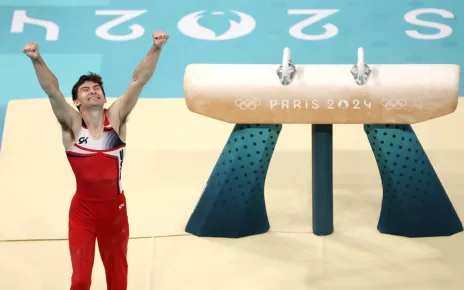UNBELIEVABLE DISCOUNTS AT AMAZON.COM ||
Big news last week on the Olympic Park slide. Perhaps you missed it amid the euphoria and phantasmagoria of Sunday night’s Paralympic closing ceremony, as the curtain finally came down on the vivid summer panorama that was Paris 2024. In the circumstances, then, the chequered fate of the ArcelorMittal Orbit – the Anish Kapoor sculpture in east London that like all the best art was named after a global steel conglomerate and fitted with a giant slide against its creator’s wishes – stands as a kind of totemic, even cautionary Olympic tale.
Officially, the Orbit has been closed since the start of 2024 for maintenance work. In practice, visitor numbers have emerged largely unscathed. Original projections of 350,000 a year were, it turns out, just another of London 2012’s grand numerical fictions. The true figure averages out at about 93,000, which given its steep maintenance costs means London taxpayers are still effectively paying for it.
But lo. Help is at hand. Last week the London Legacy Development Corporation – which runs the entire Olympic Park site – announced that the zip-wire operator Zip World would be taking over the Orbit and reopening it in 2025 after a planned £2.6m investment. “We are thrilled,” an LLDC spokesperson announced, in an official statement that promises “a whole new era of excitement and adventure right in the heart of London”.
Promises upon promises; visions upon visions; numbers plucked out of thin air; the corporate bullshit dial turned up to 25. As Paris begins to sketch out its own Olympic afterlife, the transformation of east London by the 2012 Games is often held up as a kind of shining exemplar. Leaf through the financial pages and the investor press and you will be left with the idea that London’s Games legacy has been a dazzling success story, and in many ways it has. But it does depend, in large part, on where you choose to look.
So let’s start right here, in the wiry shadow of the Orbit, on the banks of the Waterworks River where once stood a graveyard of discarded household appliances known locally as Fridge Mountain. Across the river, Zaha Hadid’s imposing Aquatics Centre, where an off-peak swim now costs £7.85 for non-members. Further east the bright lights and designer emporia of the Westfield shopping centre, and behind them – standing guard like sentinels – the grey residential towers of Victory Plaza, where a one-bedroom flat will set you back £2,500 a month. Something has been given here. But something has also been taken.
This is not, by any stretch, the time‑honoured Olympic tale of white elephants and decay. These are homes and shops and parks and roads that people actually use, even if parts of the space still feel breathtakingly deserted. Big brands and cultural institutions have moved in or are soon relocating: Ford, the BBC, the V&A Museum, avatar Abba. By almost any measure the billions of pounds in public investment has been repaid several times over. The real issue of contention is who has benefited. Who, ultimately, was all this for?
Not really the residents of Newham, Hackney and Waltham Forest, thousands of whom have been waiting years for social housing while luxury developments stud the skyline. Of the 33,000 new homes that will be built on or near the Olympic site by 2036, just over a third will be affordable, against the original bid pledge of 50%. And this in itself is a kind of sleight, given that the redefinition of “affordable housing” under the coalition government leaves it beyond the means of most lower-income families. Only around 1,000 social housing units have been constructed.
On the other hand if you are an affluent young professional, perhaps one of the many tech workers priced out of Clerkenwell and Shoreditch, this is your playground. And of course this is a more familiar Olympic story, from Rio de Janeiro to Tower Hamlets: gentrification under the guise of regeneration, a revolution for the moneyed classes that also effectively locks marginalised groups out of their own city. In the two decades to 2021 the Black population of Stratford fell from 31% to 17%. Perhaps, from a certain viewpoint, this is what sparkling success looks like.
Paris, like London, has embarked on its legacy project with noble ideals and eloquent promises. Two extended metro lines, opened just before the start of the Games, are a downpayment on the generational task of bridging the historical divide between the chocolate-box centre-ville and the poorer suburbs. The hasty cleaning of the River Seine for the triathlon events is part of a longer-term project to reclaim the river for public use. Organisers have pledged that 32% of the new homes in Saint-Denis, site of the athletes’ village and some of the worst poverty in mainland France, will be set aside for public housing.
But of course the pledge is the easy part. What defines the reality is political will, economic headroom, the gymnastics of the possible in a landscape of increasingly impoverished public sectors. And at the heart of all Olympic legacy projects is a more fundamental question: who sport is for, who should benefit from its largesse, in which direction the money should flow.
after newsletter promotion
“I didn’t bid for the Olympics because I wanted three weeks of sport,” Ken Livingstone once said. The former London mayor knew that big events are increasingly one of the few reliable drivers of infrastructure capital, of unlocking the billions required for genuine transformation. But the cranes dotting the Stratford skyline portend a very different kind of transformation to the one he envisaged.
The London housing crisis continues to accelerate. Immigrants will continue to be blamed for it. The mayor, Sadiq Khan, has tried to undo much of the damage wreaked by his fundamentally unserious predecessor Boris Johnson, whose idea of a social good was a giant slide nobody asked for. But in a way, the die has already been cast, the legacy squandered, the mistakes made. Paris, at least, still has a chance to do better.
-
Do you have an opinion on the issues raised in this article? If you would like to submit a response of up to 300 words by email to be considered for publication in our letters section, please click here.



